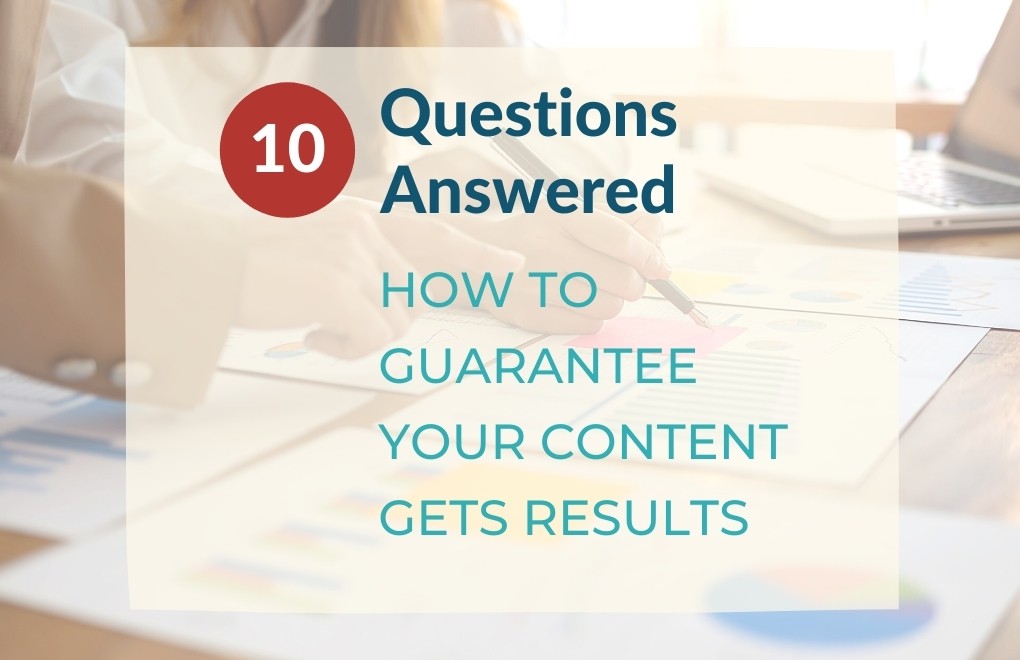Create content that doesn’t only get seen but that also grows your business.
Is your content bringing you results?
Driving new clients to your website and creating long-lasting relationships with the existing ones? Improving the experience they get and your image?
If you’re now thinking “How on earth should I know that?” you really need to read this post!
As a communications consultant for small businesses I get questions like this all the time. “How do I know if my content really works?” “What could I do to get better results and find more clients via my content?”
Now I’m answering 10 most common questions about tracking and measuring your communication and content.
1) Why should I measure my communication?
If you don’t follow the performance of your content and communication, you don’t know what works and what doesn’t. At the end of the day, you don’t know if your content even moves the needle for your business at all.
Following and tracking some key metrics gives you answers to these questions and allows you to focus your efforts on the channels and connections that matter.
2) How to get started?
Following and analysing data can seem overwhelming, if you’ve never done that consistently before.
A good way to get started is to determine 5-10 key metrics and start tracking them regularly. You don’t need to follow dozens of things at first. When you understand what your key figures are telling you, you can widen your scope.
3) Which metrics to track?
Your key figures should be the ones that are the most closely linked to your current business goals. Here are some ideas:
- Total website visits
- Unique website visitors
- Ads & promotions: link clicks to your site
- Social media follower count for each channel
- Number of newsletter subscribers
- Growth of your social media following / newsletter audience
- Newsletter conversion rate
- Sales conversion (especially important for paid promotions)
- Number of meetings or calls scheduled
- Inquiries that a message or a post generates
- Comments, shares, likes (make sure not to focus on these exclusively, because they won’t have a direct impact on your business)
4) My business is still small, is there really sense in keeping an eye on this?
Definitely! The earlier you start, the better you can focus on things that matter the most.
Following the metrics early on is also motivating, because you’ll see your business and audience grow, step by step.
5) How do I know if my content is performing well?
You can follow quantitative measures, such as the overall reach, likes, comments or shares.
In addition, you can also keep an eye on the qualitative measures: which posts create a conversation you wanted to? Which ones generated the most new leads or high-quality leads? Note also these qualitative observations in your tracking file.
6) How often should I track the metrics?
Do it at least once a month. If you do it less often, you’ll risk continuing ineffective campaigns for too long.
A weekly rhythm can work, too, but it can feel overwhelming for a small team and if you’re only starting out, seeing changes in one week isn’t easy.
7) What if I don’t have the time?
Having this insight will actually save you time because it allows you to let go of content and channels that aren’t working. If you don’t have this information, you’ll risk working on projects that aren’t bringing you results, and that is a real waste of time, isn’t it?
8) What can I do with this information?
Use all this insight to formulate your next campaigns and your content.
When you see a certain type of social media post creates the engagement you were hoping for, create more of those. When a certain blog topic skyrockets your website visitor count, dive deeper into that topic or repurpose the blog for other channels as well.
You’ll also learn when your followers are the most active and can tailor your publishing schedule to meet their schedules.
9) What kind of tools should I use to track my content?
Google Analytics offers insight to your website visitors and where they come from. Social media platforms usually offer insights on the performance of your social accounts. There are also a lot of third-party analytic apps and plug-ins but especially in the beginning, you’ll get a lot of information from the platforms and analytics.
Make sure to collate all the information in one place for you and your team. It makes long-term follow-up easier as well. You’ll also want to make sure you have a business account on those platforms where it’s possible because a business account allows you to access more detailed insights.
10) What if my performance gets worse?
Use that information! Your follower count and reach can fluctuate due to the seasons, world events and for example your campaigns.
The longer you keep following the figures, the easier it gets to recognise and exclude those kinds of external factors and focus on what you can impact.
Do you want more personal guidance?
These questions and answers cover some of the most important areas of communication performance tracking and will get you started with setting up your own tracking system.
Sometimes it can feel hard to pick the right metrics to follow or make the right conclusions based on your data. If you have questions or want more personalised guidance, book a complementary Strategy Mapping Call with me and we can finalise your communication plan together. During this 45-minute call, we’ll talk about your plans and goals and map out the next steps to take to keep growing your business and turning your vision into reality more quickly.







Trackbacks/Pingbacks